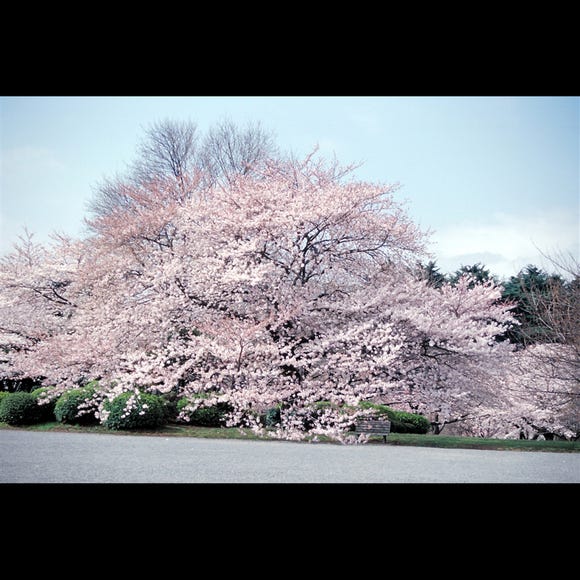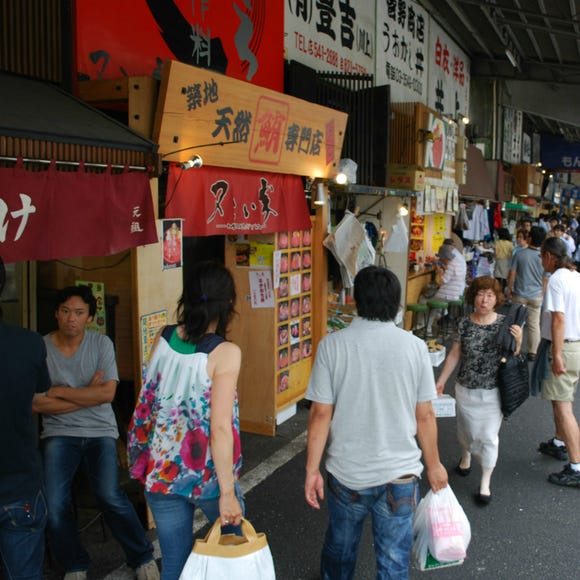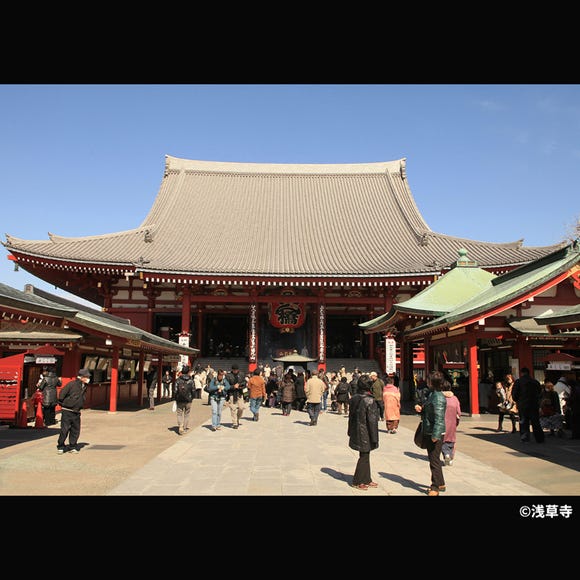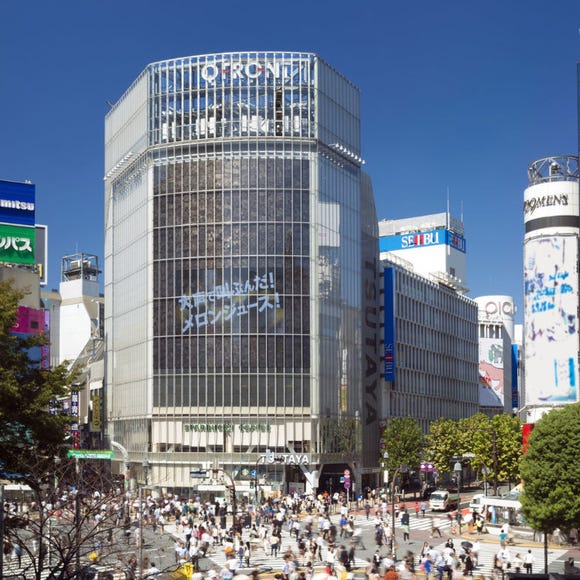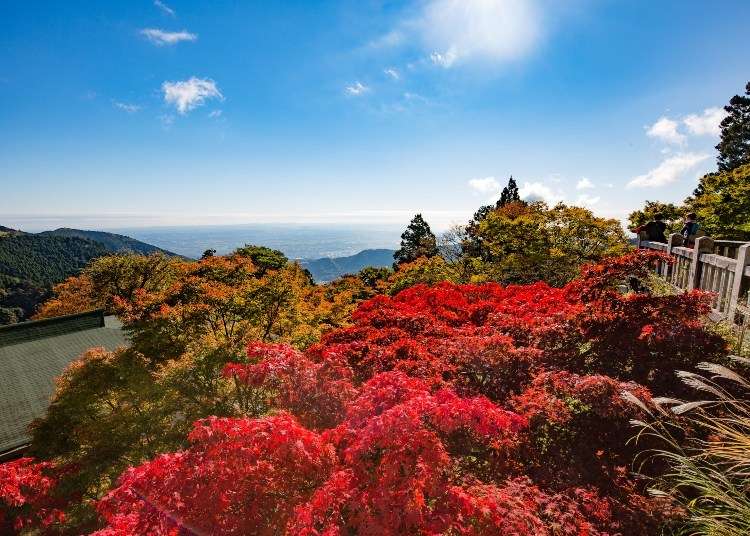
What's a truly Japanese way to enjoy the autumn season? If you immediately thought of someone relaxing in a hot spring while gazing at an idyllic landscape covered in beautiful shades of red and yellow, well, you wouldn't be too far off from the truth!
As a country famous for its scenic autumn leaves, there are plenty of places in Japan you can visit for the best views, including places where you can take a day trip from Tokyo city itself.
In fact, we'll even throw in that hot spring visit you thought about at the outset. This travel plan will take you to the Oyama area in Kanagawa Prefecture, where you'll get to see the sights, enjoy Iseharashi Oyama's locally renowned tofu cuisine, and soak in Hadano city's Tsurumaki hot spring at leisure.
- Table of Contents
-
- Getting to Oyama: 50-minute ride via Romancecar from Shinjuku
- Arriving in Oyama: After ascending a precipitous slope of stone steps...
- Magnificent view of autumn leaves from the cable car
- Smack your lips over the Oyama tofu being sold along the spinning top path
- Tsurumaki Onsen JINYA: Enjoy an elegant bath and satisfying meal at a prestigious tavern
- Wrap Up
- Related Articles
Getting to Oyama: 50-minute ride via Romancecar from Shinjuku
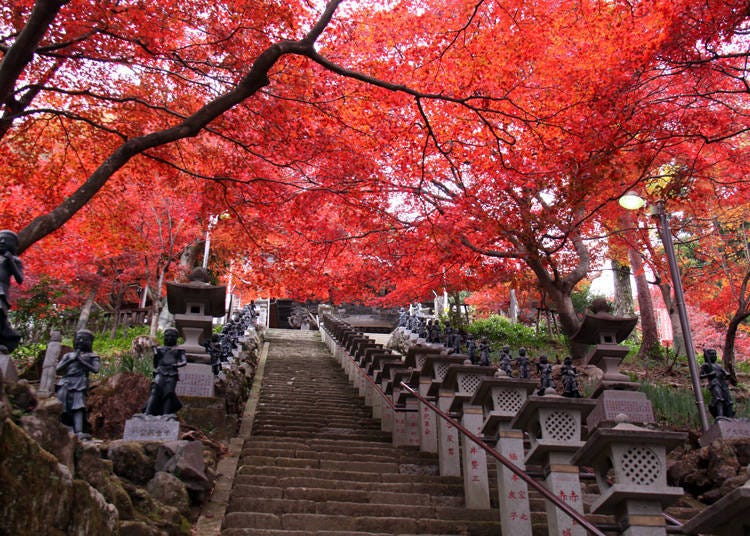
Oyama is such a popular spot for maple leaves viewing during autumn, it's earned itself the moniker, "Raining Mountain", a shorter version of the title, "The Mountain that Rains Candy". People have visited this mountain to pray at its shrines for rain, good harvests, and prosperous business dealings since ancient times, making it a powerful spiritual spot as well.
This pilgrimage course is known as the "Oyama Shrine Visit", an activity that has been recognized as a Japan Heritage. Part of the traditional Oyama Shrine Visit package includes the visiting of hot springs as well, and to cut down on transportation hassles, we'll be purchasing the convenient Tanzawa-Oyama Freepass being offered by Odakyu Electric Railway.
This pass comes with a round trip ticket that will get you from any station on the Odakyu Line to any station between Hon-Atsugi Station and Shibusawa Station. It also allows you unlimited train rides on the Odakyu Line between Hon-Atsugi Station and Shibusawa Station, unlimited rides on Kanachu buses within the designated area, and unlimited rides on the Oyama Cable Car (if you go for the Ticket A option). Pay an extra fee for the Limited Express Romancecar ticket and you can also get to enjoy riding on the comfortable Romancecar on top of all the other perks!
To buy the Limited Express ticket, let the counter staff know your destination on the Romancecar when getting the Freepass and they'll sort out the cost for you.
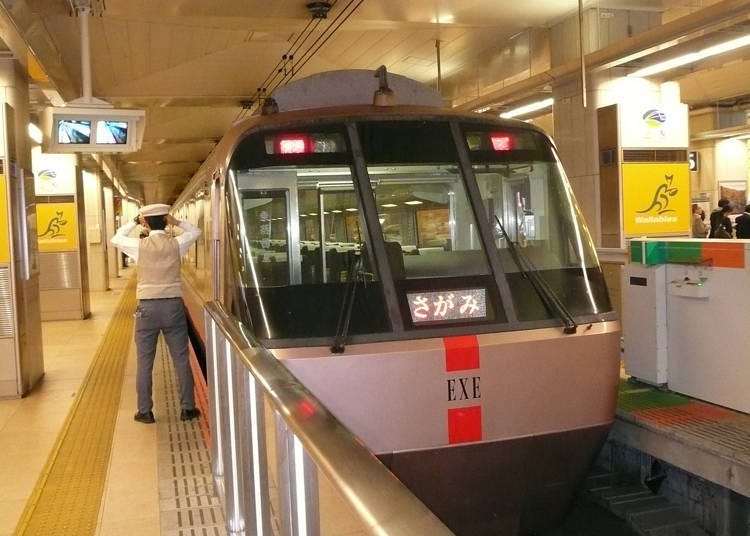
Our choice for this trip is the Tanzawa-Oyama Freepass and Romancecar ticket set. We set off from Shinjuku in a Romancecar at 7 a.m. and lounge about in the comfortable reclining seat until some time after 8 a.m., when we reach our first stop for the day: Isehara Station.
Head down to the Kanachu Bus interchange at Isehara Station's north exit and take bus 10 or 11 heading towards Oyama Cable and stop at the Oyama Cable Terminal Bus Stop.
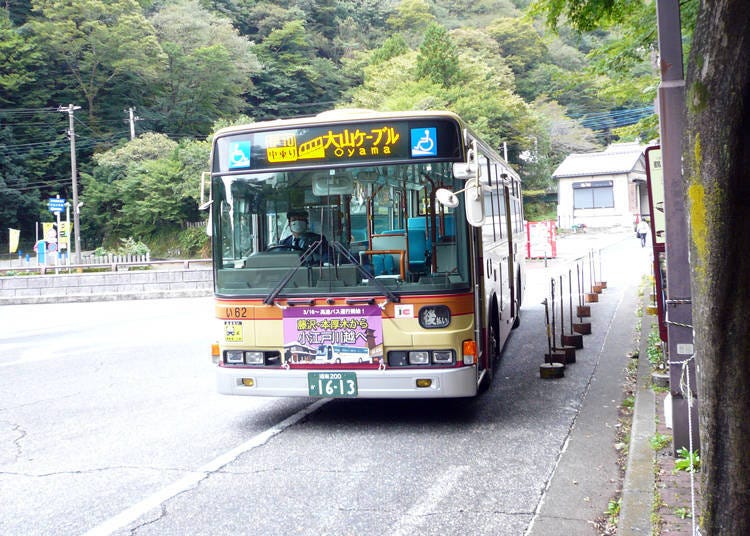
- Ticket A
- Comes with a round trip ticket that will get you from any station on the Odakyu Line to any station between Hon-Atsugi Station and Shibusawa Station. It also allows you unlimited rides on the Odakyu Line and Kanachu buses within designated areas, and unlimited rides on the Oyama Cable Car.
Price from stations on Odakyu Lines (may differ depending on starting station): From Shinjuku Station - Adults 2,520 yen; Children 1,270 yen
- Ticket B
- Comes with a round trip ticket that will get you from any station on the Odakyu Line to any station between Hon-Atsugi Station and Shibusawa Station. It also allows you unlimited rides on the Odakyu Line and Kanachu buses within designated areas. Price from stations on Odakyu Lines (may differ depending on starting station): From Shinjuku Station - Adults 1,560 yen; Children 790 yen
- Romancecar Limited Express Ticket add-on fee
- (Shinjuku to Isehara): 630 yen
Arriving in Oyama: After ascending a precipitous slope of stone steps...
The bus takes you through town and climbs up a rather steep mountain slope to reach its terminal stop, the Oyama Cable Bus Stop in about half an hour. Once you alight from the bus, you'll be surrounded by the cool and crisp air of the mountain that refreshes both your body and soul. There may be some truth to the mountain being a powerful place of spiritual refreshment after all!
Once you've finished adjusting to the cooler temperature, it's time to walk further up the mountain from the bus stop. Some visitors choose to hike their way up, but since we already have the Freepass with cable car access, let's make use of that instead!
That said, we'll still have to climb up a set of stone steps to reach the Oyama Cable Car platform proper. This is a pretty hard trek for those who seldom exercise, so take note of that and have plenty of rest stops in between the climb if you need to.
To give you a rough idea about what you'll be up against: There are 382 steps to the Oyama Cable station (about 15 minutes) and 928 steps until Oyama Shrine (about 40 minutes). Further up in about 1,610 steps (60 minutes) is the Oyama Afuri Shrine, via the onnazaka (women's slope) or the otokozaka (men's slope). The durations mentioned are all estimates and will vary vastly from person to person. We had to rest for quite a few times during the climb, so it took about 30 minutes for us to reach the cable car station - twice the estimated time!
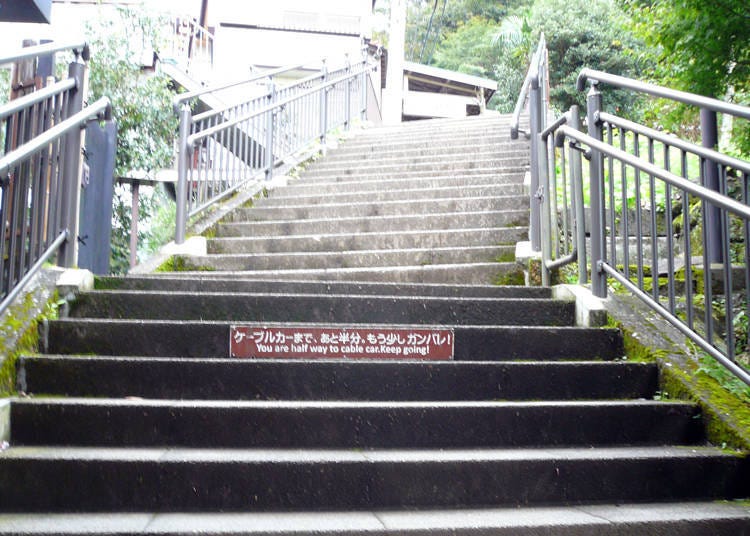
Because we started climbing at about 8:30 a.m., the souvenir shops and eateries located along the path had yet to open for business. These are shops where you can buy local specialties like Oyama tofu and Oyama spinning tops, among other interesting items. We forged onwards while promising ourselves to drop by on the way down later.
The stone steps are decked with tiles designed with Oyama spinning tops. If you count them while making your way up, you'll be able to know about how far along you are to your destination. Give it a go!
Magnificent view of autumn leaves from the cable car
Upon reaching Oyama Cable Station, you'll be greeted by a modern-looking green funicular cable car. Hop onto the vehicle and you'll be on your way to an undershrine of the venerable Oyama Afuri Shrine, a long-established building with over 2,200 years of history behind it.
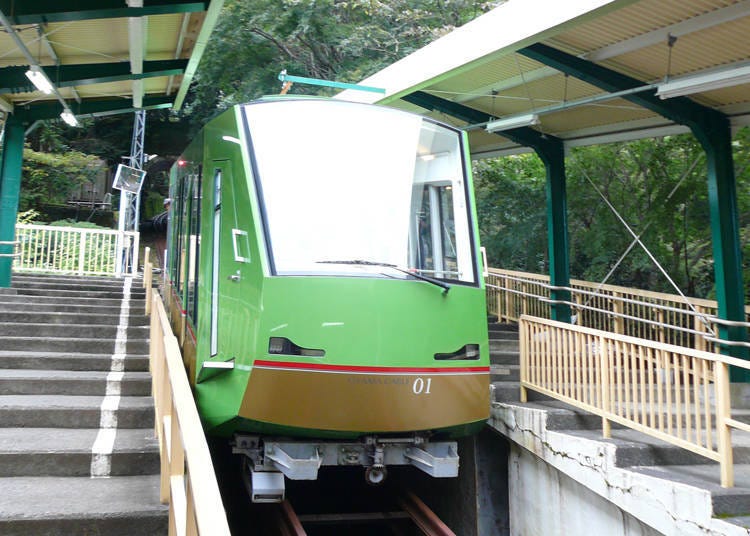
As the cable car slowly makes its way up to Oyama Shrine, and then the terminal station at Afuri Shrine, you'll be treated with a spectacular view of the mountain's landscape outside the window, and before you even realize it, you'll be at your destination! This is the midpoint of Oyama, about 700 meters, or about 2,296 feet above sea level, and it offers visitors a panoramic view of Enoshima or Sagami Bay.
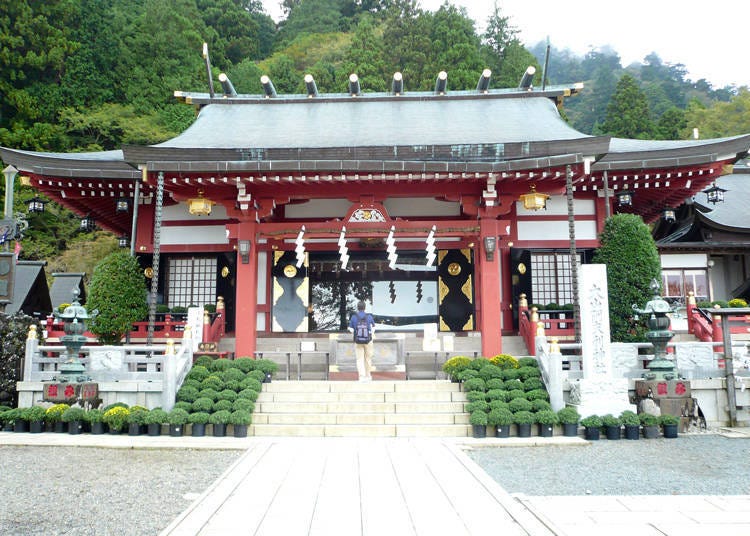
Trek up at your own pace for another 1.5 hours from here and you'll reach Oyama Afuri Shrine's main hall. The path along the way to the shrine is a very popular autumn leaves viewing spot where many flock to in order to admire the beautiful and picturesque view once the fall season rolls in.
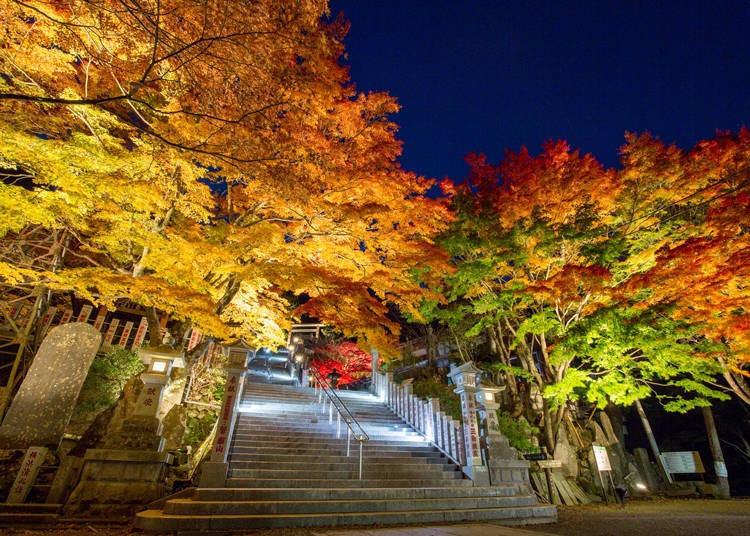
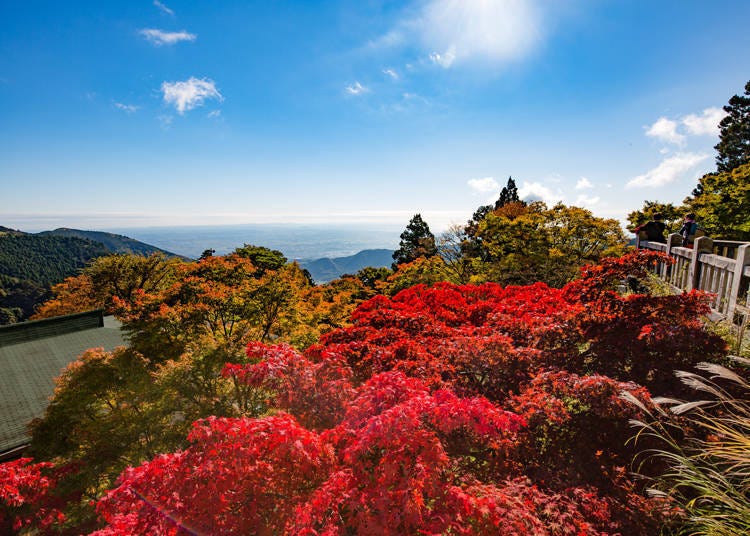
-
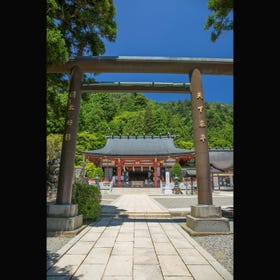
-
Address
355, Oyama, Isehara-shi, Kanagawa, 259-1107
View Map -
Nearest Station
Isehara Station (Odakyu Odawara Line)
- Phone Number 0463-95-2006
-
Address
355, Oyama, Isehara-shi, Kanagawa, 259-1107
There's an observatory deck by the name of Fujimidai located halfway through the climb, so named for the great view of Mount Fuji it offers. To reach this area and the areas higher up, however, some light hiking gear will be necessary. Your next destination is Oyama Shrine, also known as Oyama Fudō, as you're coming back down on the cable car.
Oyama Shrine is a well-known autumn leaves viewing spot, located about 200 meters, or about 656 feet away from the Oyama Shrine cable car station - just three minutes or so on foot. This shrine was inaugurated in 755 C.E by Monk Rōben of Nara's Tōdai Shrine.
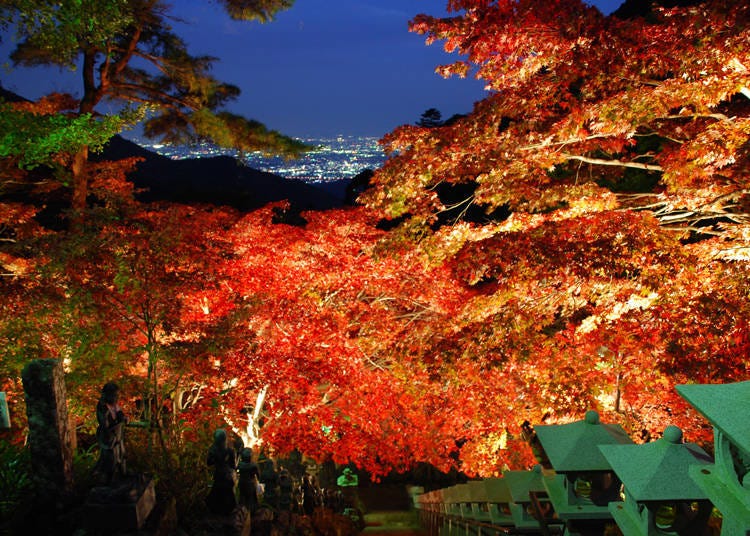
There's an interesting activity you can try at Oyama Shrine, called kawarake-nage (earthenware-throwing), if you're so inclined. As the name suggests, you throw a piece of earthenware plate down a designated cliff with the idea that it will carry away your plagues and bad luck. When the autumn leaves are at their prime from mid-November to end-November, the bright red foliage around the stone steps leading to the main hall surrounds the many visitors to the shrine like a crimson tunnel, warmly ushering them within.
-
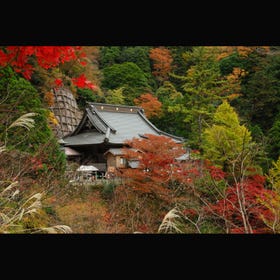
-
Address
724, Oyama, Isehara-shi, Kanagawa, 259-1107
View Map -
Nearest Station
Isehara Station (Odakyu Odawara Line)
- Phone Number 0463-95-2011
-
Address
724, Oyama, Isehara-shi, Kanagawa, 259-1107
Smack your lips over the Oyama tofu being sold along the spinning top path
Take in the beautiful red autumn leaves found all around the mountain valley as you make your way back to Oyama Cable station. Head down the stone steps from here and take a peek at all the souvenir stores and restaurants located along this path. Do make plans to try the tofu cuisine here as well. This is one of the dishes Oyama is best known for, after all!
Once you enter the spinning top path, you'll probably find yourself being attracted to Tsukamoto, a folk craft store selling all sorts of Oyama traditional spinning tops. Once you've had your fill of browsing and shopping, a lady from the opposite store may beckon you with the enticing question, "Would you like some tofu before you go?"
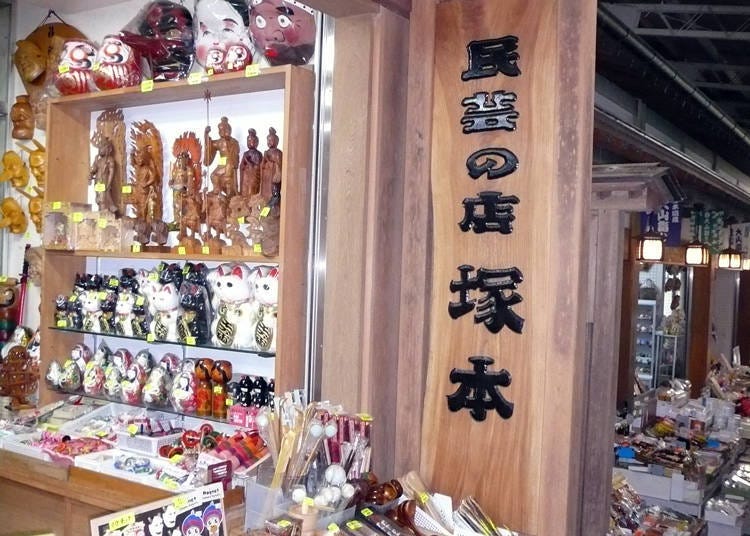
Nod and you'll be brought to the souvenir store's rest stop, also called Tsukamoto. Or just head there yourself - it's completely fine too! Here, you can enjoy Oyama specialty foods like tofu, tokoroten (seaweed jelly noodles), and soba (buckwheat noodles). Because the water at Oyama is pure and tasty, the tofu made from it is tasty as well. Though many restaurants offer tofu as part of a set meal, Tsukamoto is special in that they promote tofu as an ala carte dish to be eaten by itself, either warm or chilled, so that customers can taste just how good the tofu is without any being distracted by other dishes.
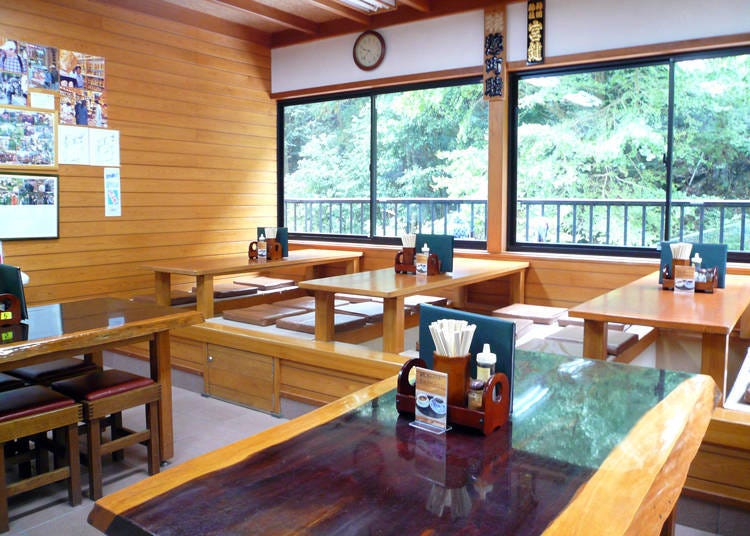
To truly experience the taste of Oyama, try the "Attakayakko Miso Tofu (430 yen, tax included)" dish. The mellow taste of the tofu allows you to really relish the plain but delicious flavor. The homemade miso paste that's slathered generously on top of the block of tofu enhances the original taste flawlessly.
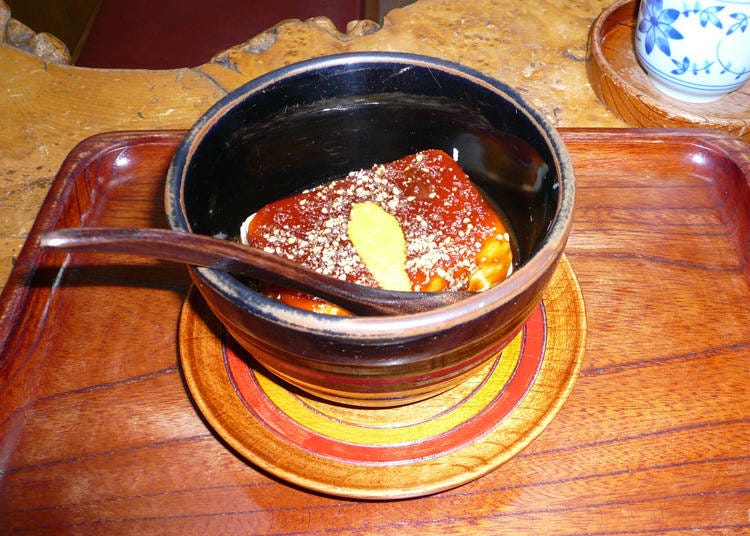
-
Tsukamotoつかもと
- Address 658, Oyama, Isehara Shi, Kanagawa Ken, 259-1107, Japan
-
Nearest Station
10-minute walk from Oyama Cable Bus Stop on the Kanachu bus route
- Phone Number 0463-95-4391
Hours: 9:00 a.m. -- 4:00 p.m.
Closed: Not fixed
After sating your stomach, depart from Tsukamoto and continue down the stone steps, passing by the nearly 20 souvenir shops and eateries on both sides of the path, offering tofu set meals, konnyaku (yam cake), kyarabuki (butterbur in soy sauce), local sake, ice-cream, tofu with minced meat, and other good stuff.
Once again, because we were there a little too early, most of the shops were not opened yet, and so we missed out on quite a lot of fun! For your future reference, many of the shops here will only start opening for business at around 11:00 a.m.
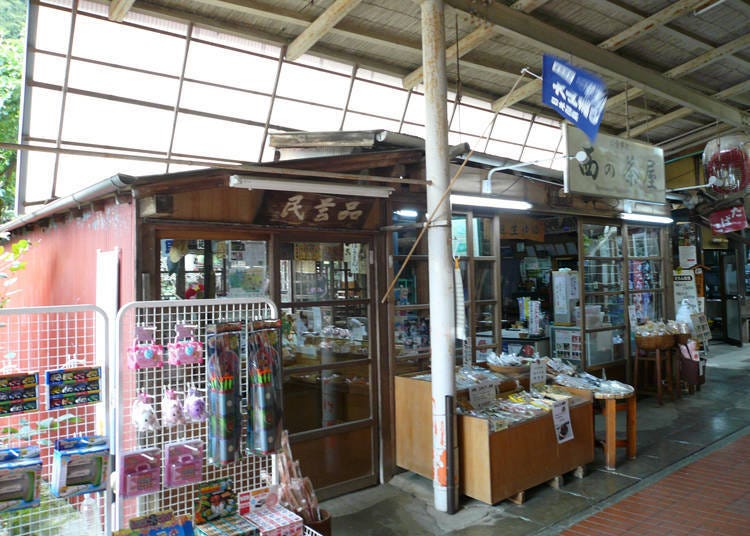
The spinning top path to the shrine is also like a compact version of an Edo or Showa period streetscape, allowing visitors to bask in the authentic historical and cultural vibe of olden Japan in its most natural form.
Tsurumaki Onsen JINYA: Enjoy an elegant bath and satisfying meal at a prestigious tavern
At long last, we've reached the highlight of today's itinerary: Tsurumaki hot spring! To get here, board a Kanachu bus from Oyama Cable Bus Stop again and return to Isehara Station on the Odakyu Line, then head for Tsurumaki-Onsen Station, also on the Odakyu Line.
During the weekends and on public holidays until December 1st, there will be a direct Kanachu bus service from Oyama Cable Bus Stop to Tsurumaki hot spring (check the official website for more information).
Tsurumaki hot spring, located in Kanagawa Prefecture's Hadano city is one of the most well-known hot springs in the world that contains calcium in its spring waters. Locals have been familiar with this hot spring since the Meiji era (1868 C.E. to 1912 C.E.).
Our recommendation is to go for the hot spring in a ryokan, or Japanese-style inn called Jinya, which was built on the villa grounds of Wada Yoshimori, an expert archer and feudal vassal of the shōgun Minamoto-no-Yoritomo.
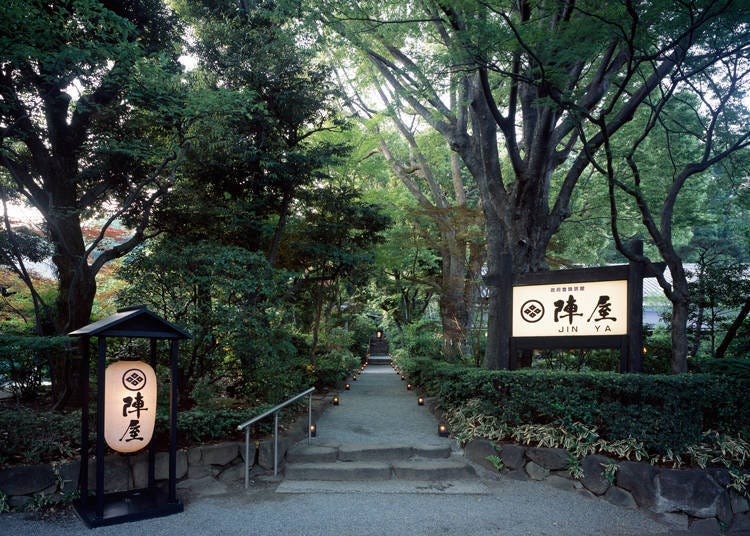
Jinya is surrounded by about 33,000 square meters (about 3,552 square feet) of well-maintained Japanese gardens that make full use of the natural bubbling water streams and bamboo forests in the vicinity to beautify the place.
The pure Japanese aesthetics of the inn is further accentuated by the seasonal food it offers and its famous baths that have deep historical significance. What better way to end your day trip than to soak your tired body in this uniquely Japanese setting, right?
It takes about four minutes to walk from the station to Jinya, and you'll know you've reached when you see the large drum adorning its entrance. Reception staff will beat the drum to inform the other staff in the building of incoming guests. Inside, you'll find a few buildings like Minamoto Hall, Miyabi Hall, and Matsukaze Hall, each connected to a piece of Japan's history in its own way.
You may think that your wallet is not quite ready to take on such a prestigious lodge, but it's not as scary as it sounds if you go for the package that allows you to take a dip in their hot springs and enjoy a good meal without staying over!
The "Day Trip Hot Spring and Restaurant Package (Seasonal Set Meal)" is a reservation-only plan available for a reasonable 5,000 yen excluding tax. This can be done via their website or over the phone, and since they have an English website, international visitors can make a booking with ease as well!
Once you sit down for your meal, course after course of delicious Japanese dishes like lightly steamed gluten with thick sauce, sesame tofu steamed in spring water, and fried shrimps will be served to fill up your tummy. For the main dish, we went with the hearty "Yamato Pork Pickled in Sakura Miso".
The way the cooks use dashi, or Japanese soup stock, to bring out the juicy flavors of the ingredients is impressive and convinces you that this is a facility that truly values tradition and history indeed.
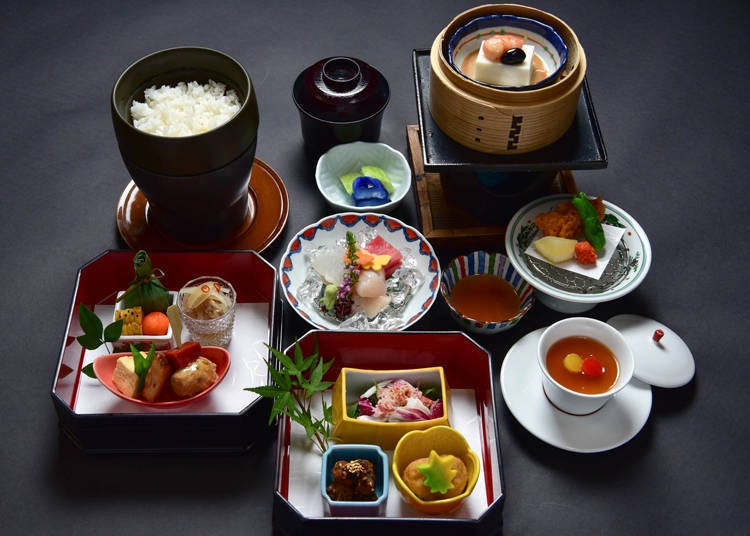
After relishing your meal, head over to the inn's history-rich hot springs for a nice, long soak to work out those muscle knots you've developed as you went about finding the best autumn leaves spot earlier in the day. It's not every day you get to treat your body to a soothing soak in a famous hot spring in the midst of a beautiful Japanese garden that's full of seasonal flavors, so take your time to enjoy this exquisitely special moment!

-
Tsurumaki Onsen JINYA鶴巻温泉 元湯 陣屋
- Address 2-8-24 Tsurumaki-kita, Hadano-shi, Kanagawa 257-0001, Japan
-
Nearest Station
小田急線「鶴巻温泉」駅から徒歩4分
- Phone Number 0463-77-1300
Day Trip Hot Spring and Restaurant Package (Seasonal Set Meal) 11:30 - 3:00 p.m. (4:00 p.m. last entry): 5,000 yen (tax excluded)
Day trip hot spring hours: 11:30 a.m. -- 11:00 p.m. - Max. 2 hours (10:00 p.m. last entry)
Inner bath & garden view open-air bath Akashi / Aoi: 11:30 a.m. - 11:00 p.m.
Mountain view open-air bath Yamafuji / Yamazakura: 11:30 a.m. - 3:00 p.m.
Bath only
Price: Adults - 2,400 yen ; Minors 10 to 12 - 1,680 yen; Minors 6 to 9 - 1,200 yen; Minors 0 to 5 - 720 yen; Free drink / Restroom usage included (all listed prices exclude tax)
Prices include hot spring entry, bath towel, face towel, amenities, locker for valuables
Wrap Up
Beautiful autumn leaves and relaxing hot spring soaks - you can easily and conveniently get the best of both activities with the Tanzawa-Oyama Freepass that allows you to do all of that as a day trip from Tokyo city itself. If Japan's famous fall foliage is one of the objectives for your trip, then this is definitely an itinerary worth some serious consideration!
Written by: Junichi Minami - Dali Corporation. English translation by: Huimin Pan.
Related Articles
- Area
- Category
*Prices and options mentioned are subject to change.
*Unless stated otherwise, all prices include tax.
Limited time offer: 10% discount coupons available now!
-

Step Into the Story: Inside Immersive Fort Tokyo
-

A Complete Guide to the JR West Kansai Area Pass
-

Opened in Spring 2024! What to do at Tokyu Plaza Harajuku Harakado
-

15 Must-Try Restaurants in Ikebukuro: From Aged Yakiniku to All-You-Can-Eat Sushi, Plus Adorable Animal Cafés
-

The CASIO S100: How CASIO's Masterpiece Calculator Redefines Business Elegance With Japan-Made Reliability
-

Best Things to Do in Tokyo in April 2024: Events, Festivals & More
-
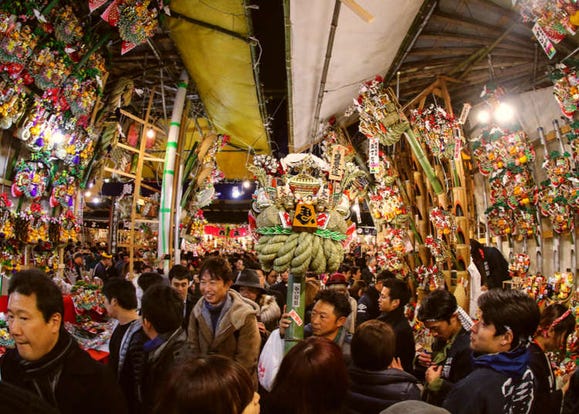
Tori-no-Ichi Fair: Experiencing Asakusa's Amazing Festival! (Nov 11 & 23, 2023)
-

Enjoy Halloween in Japan 2023: LIVE JAPAN Guide to Shibuya Halloween & Other Fun Events
-
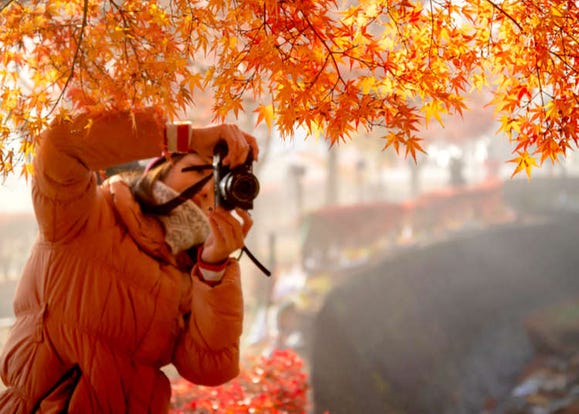
Tips & Advice for Planning a Trip to Tokyo in Autumn
-

Autumn in Tokyo 2024: 16 Best Places to See Fall Foliage in Tokyo
-
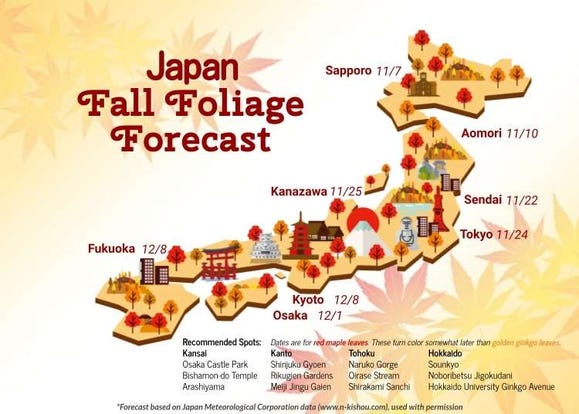
Autumn in Japan 2024: Fall Foliage Forecast & Where to Enjoy the Colorful Leaves (+Tour Info)
-
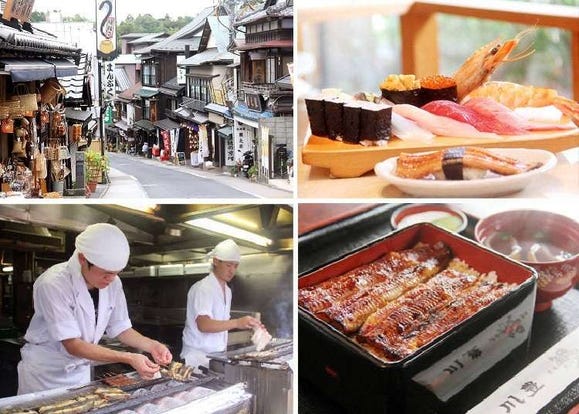
(Video) Walking Tour along Narita Omotesando - Quaint Historical Village near Narita Airport!
- #best ramen tokyo
- #what to buy in ameyoko
- #what to bring to japan
- #new years in tokyo
- #best izakaya shinjuku
- #things to do tokyo
- #japanese nail trends
- #what to do in odaiba
- #onsen tattoo friendly tokyo
- #daiso
- #best sushi ginza
- #japanese convenience store snacks
- #best yakiniku shibuya
- #japanese fashion culture
- #best japanese soft drinks















